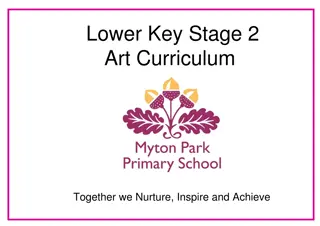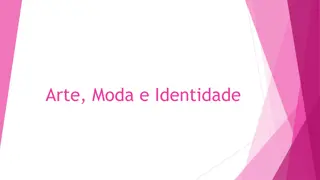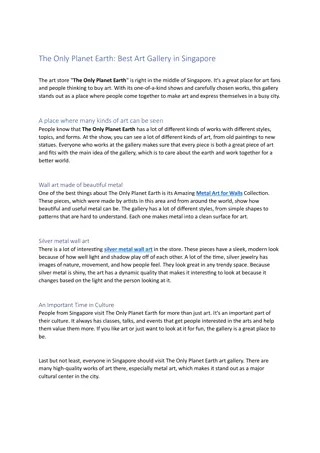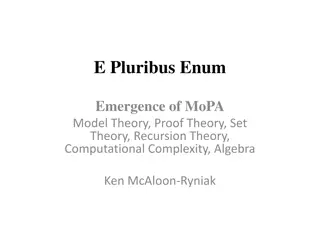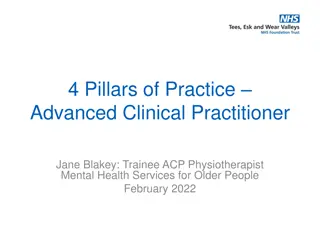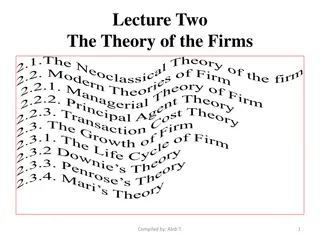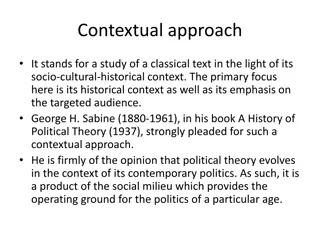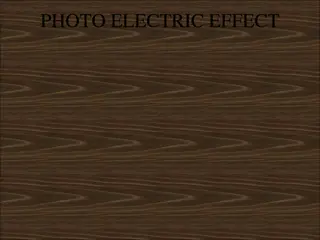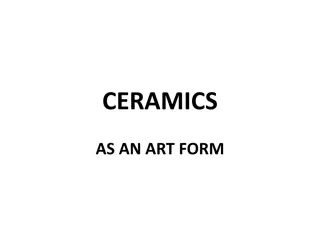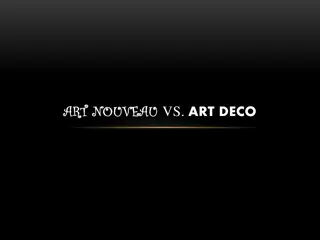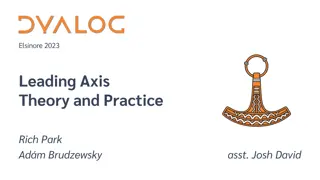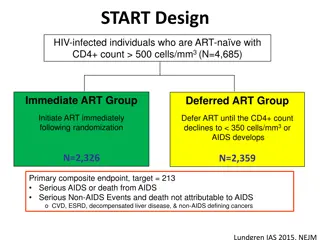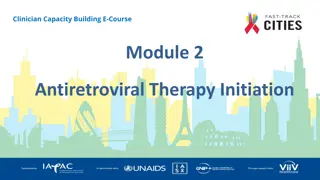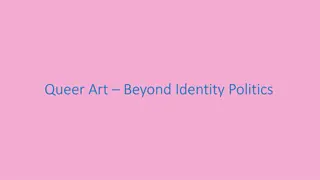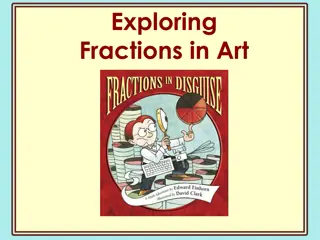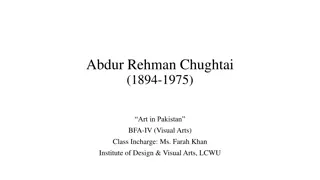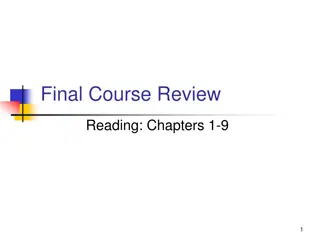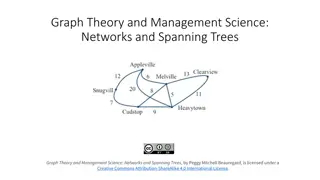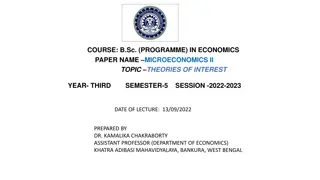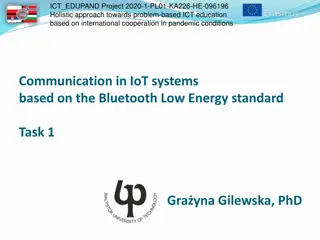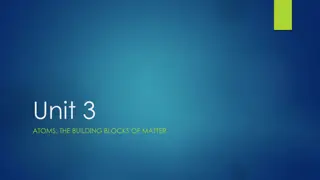Art and Information: Connecting Theory and Practice
Explore the intersection of art and information through a framework that emphasizes strategic exploration and keyword strategies in searching for images. Lightning talks and workshops delve into the importance of keywords, cataloging images, and developing search strategies. Learning objectives include understanding successful keyword strategies for image searching and utilizing image databases effectively.
Download Presentation

Please find below an Image/Link to download the presentation.
The content on the website is provided AS IS for your information and personal use only. It may not be sold, licensed, or shared on other websites without obtaining consent from the author.If you encounter any issues during the download, it is possible that the publisher has removed the file from their server.
You are allowed to download the files provided on this website for personal or commercial use, subject to the condition that they are used lawfully. All files are the property of their respective owners.
The content on the website is provided AS IS for your information and personal use only. It may not be sold, licensed, or shared on other websites without obtaining consent from the author.
E N D
Presentation Transcript
REIMAGINING THE FRAME: CONNECTING ART TO THE FRAMEWORK IN THEORY AND IN PRACTICE
TODAYS SESSION 1. Framework Tool/Activity Lightning Talks 1. Anna Boutin-Cooper: Searching as Strategic Exploration 2. Alex Watkins: Authority is Constructed and Contextual 3. Claire Powell: Information Has Value 4. Shannon Robinson: Informed Learning and Assessment 2. Workshop 3. Summary and Questions
"CATALOGING" IMAGES: LOOKING FOR KEYWORDS Anna Boutin-Cooper
"Searching for information is often nonlinear and iterative, requiring the evaluation of a range of information sources and the mental flexibility to pursue alternative avenues as new understanding develops." Searching As Strategic Exploration, Framework for Information Literacy for Higher Education
SEARCHING AS STRATEGIC EXPLORATION KNOWLEDGE PRACTICES Matching information needs and search strategies to the appropriate search tools DISPOSITIONS Exhibiting mental flexibility and creativity in searching Understanding that first attempts at searching do not always produce adequate results Using different kinds of searching language appropriately Text taken directly from the ACRL Framework for Information Literacy in Higher Education, 2016.
SEARCHING AS STRATEGIC EXPLORATION Importance of the "right" keywords Discussion of what makes a "good" keyword v. a "bad" keyword Context-specific! How to loop searching frame in with art history class? Development of "cataloging" image activity
LEARNING OBJECTIVES By the end of class, students will understand how to construct successful keyword strategies for image searching. By the end of class, students will be able to search for images in Artstor and other image databases, in order to fulfill their image needs.
KEYWORDS Red Blue Textile Embroidery Quilt Woven Shawl Women Flowers Floral Image credit: The Metropolitan Museum of Art
SUCCESSFUL KEYWORDS Red Blue Textile Embroidery Quilt Woven Shawl Women Flowers Floral Image credit: The Metropolitan Museum of Art
TEACHING INCLUSIVE SOURCE EVALUATION FOR RESEARCHING NATIVE ART Alex Watkins
AUTHORITY IS CULTURALLY CONSTRUCTED Culturally specific systems of knowledge determine who is an authority and what knowledge is authoritative Librarians traditionally teach just one construction of authority, academic, and the specific markers and source types that are considered authoritative in this community Academia excludes and silences knowledge that is not constructed in this way IL instruction for research on Native art must acknowledge and value Native knowledge, but traditional modes of source evaluation instruction excludes this knowledge
KNOWLEDGE SYSTEMS / WAYS OF KNOWING ACADEMIC KNOWLEDGE Citations to the written record NATIVE KNOWLEDGE Oral tradition Wisdom of elders Credentials experts Community agreement, proven utility Peer Review
LEARNING OBJECTIVES Students understand that authority is constructed based on cultural systems of knowledge and ways of knowing. Students understand that indigenous authority is different from but not less than Western conceptions of authority. Students question the Western system of authority as default or natural. Students can identify and explain the different markers of authority in Western and indigenous cultures. Students seek out native voices and can articulate how and why native understandings of art are different from Western interpretations.
Scholarly Knowledge Indigenous Knowledge How or in what form is this knowledge disseminated/communicated? What kind of people are considered to be authorities in these spheres of knowledge? What qualifies them to be authorities? Who s the audience of this knowledge? What is the purpose of this type of knowledge? How can each type of knowledge be useful in interpreting and understanding art?
Through what ways/information formats do each of these groups communicate their ideas and knowledge? Where do these communities get information/what constitutes valid evidence in this community For what purpose, needs or questions would you seek out information from this community? What advantages as well as difficulties or challenges might there be to using information from this community: Who is considered an authority in this type of community and why? Communities: Wikipedia Gallery Museum Academic Indigenous
VALUING CONTRIBUTIONS: STUDENT INFORMATIONAL INSIGHTS AS A COMMODITY Claire Powell
INFORMATION HAS VALUE KNOWLEDGE PRACTICES Deciding where and how their information is published DISPOSITIONS Valuing the skills, time, and effort needed to produce knowledge Seeing themselves as contributors to the information marketplace rather than only consumers of it Understand how the commodification of their personal information and online interactions affects the information they receive and the information they produce or disseminate online Text taken directly from the ACRL Framework for Information Literacy in Higher Education, 2016.
FACULTY COLLABORATION Relaying the value of students own contributions to the art and design community Identifying relevant publishing outlets Connecting the dissemination of personal skills and knowledge to success in the industry and networking opportunities Authentic learning and professional opportunities related to commodifying their exclusive information
LEARNING OBJECTIVES Students will demonstrate an understanding of relevant publishing channels related to their discipline and information type Students will identify personal skills and information for potential publishing opportunities Students will be able to articulate the importance of information within their industry and different forms of its commodification
INFORMED LEARNING Shannon Robinson
INFORMED LEARNING Informed learning brings learner-centered, experiential, and reflective approaches to the information literacy agenda. (Bruce 2008) Informed learning . . . takes into account learners experiences promotes the simultaneous development of discipline + process learning is about changes in experience
INFORMED LEARNING SEVEN FACES OF INFORMED LEARNING Knowledge Construction Experience Information Awareness + Communication Experience Knowledge Extension Experience Sourcing Information Experience Wisdom Experience (Bruce 1997, 2008) Information Process Experience Information Control Experience
INFORMED LEARNING CONTENT what should learners know about the subject + about information literacy? PERSONAL RELEVANCE what good is information literacy to me? SOCIAL IMPACT how does information literacy impact society? COMPETENCY what should learners be able to do? RELATIONAL bringing about awareness of the critical ways of seeing or experiencing (Bruce 2008) LEARNING TO LEARN what does it mean to think like an informed learner in the professional environment?
INFORMED LEARNING TO FRAMEWORK identifying disciplinary attributes of authority through observation of experts in their field a subjective notion that must be investigated by the learner, both personally + professionally critical awareness about how one's own background influences how authority is perceived + determined Competency Frame Authority is Constructed + Contextual is experienced as... Through the lens of the ... Learning to Learn Frame Personal Relevance Frame
ASSESSMENT CONTENT is objective + measures how much has been learned PERSONAL RELEVANCE is cumulative (portfolio) + self-reflective COMPETENCY determines level of skill achieved SOCIAL IMPACT prompts reflection on the impact of information literacy LEARNING TO LEARN is complex, where contextual problems are posed RELATIONAL is designed to reveal ways of seeing or experiencing the phenomenon
ASSESSMENT WHEN YOU WERE A STUDENT (LEARNING SOMETHING NEW), HOW DID A TEACHER / COACH / TUTOR / MENTOR Encourage you to consider your own personal experiences + how they contributed to your learning Help you adopt the language + methods (practices, processes) of a particular subject or discipline Encourage you to consider the experiences + perspectives of others + how that contributed to your learning Invite you into the discipline, to become part of that community + engage with its members
REFERENCES Informed Learning Applications: Insights from Research + Practice edited by Kim L. Ranger (Bingley: Emerald, 2019) IMPACT Learning: Librarians at the Forefront of Change in Higher Education by Clarence Maybee (Cambridge: Chandos Publishing 2018) Sociocultural Theories + Their Application in Information Literacy Research + Education by Li Wang, Christine Bruce + Hilary Hughes (Australian Academic + Research Libraries 42(4) 2011) Informed Learning by Christine Bruce (Chicago: Association of College & Research Libraries 2008) The Seven Faces of Information Literacy by Christine Bruce (Adelaide: Auslib Press 1997) Situated Learning: Legitimate Peripheral Participation by Jean Lave + Etienne Wenger 1991 Mind in Society: The Development of Higher Psychological Processes by Lev Vygotsky (+ Michael Cole) [1981]
WORKSHOP Developing activities and assessment that link art to the Framework in your classes
EXPLORING A FRAME AND DEVELOPING LEARNING OBJECTIVES ~10 minutes Working in your breakout room: 1. Identify ways your frame manifests in the field of art and art history. What are some of the unique issues, methods, or difficulties faced by learners in visual arts disciplines in regards to this frame? 2. Use worksheets to generate at least one learning objective for one of your previously identified manifestations
DEVELOPING AN ACTIVITY AND ASSESSMENT PLAN ~20 minutes Working in your breakout room: 1. Use worksheets to develop an activity for your learning objectives 2. Use the PDF ARLIS 2020 Informed Learning to discuss and develop opportunities for assessing your learners.
DISCUSSION: bit.ly/3g8qOKp Share what we came up with!
QUESTIONS? Anna aboutinc@fandm.edu Shannon smrob@upenn.edu Claire cpowell3@c.ringling.edu


